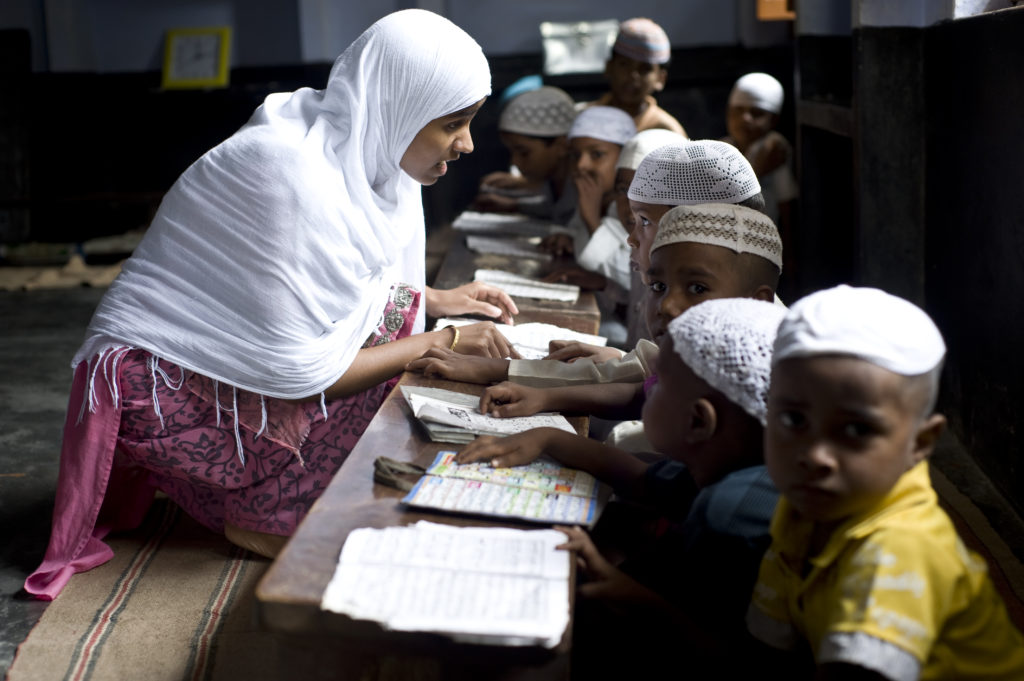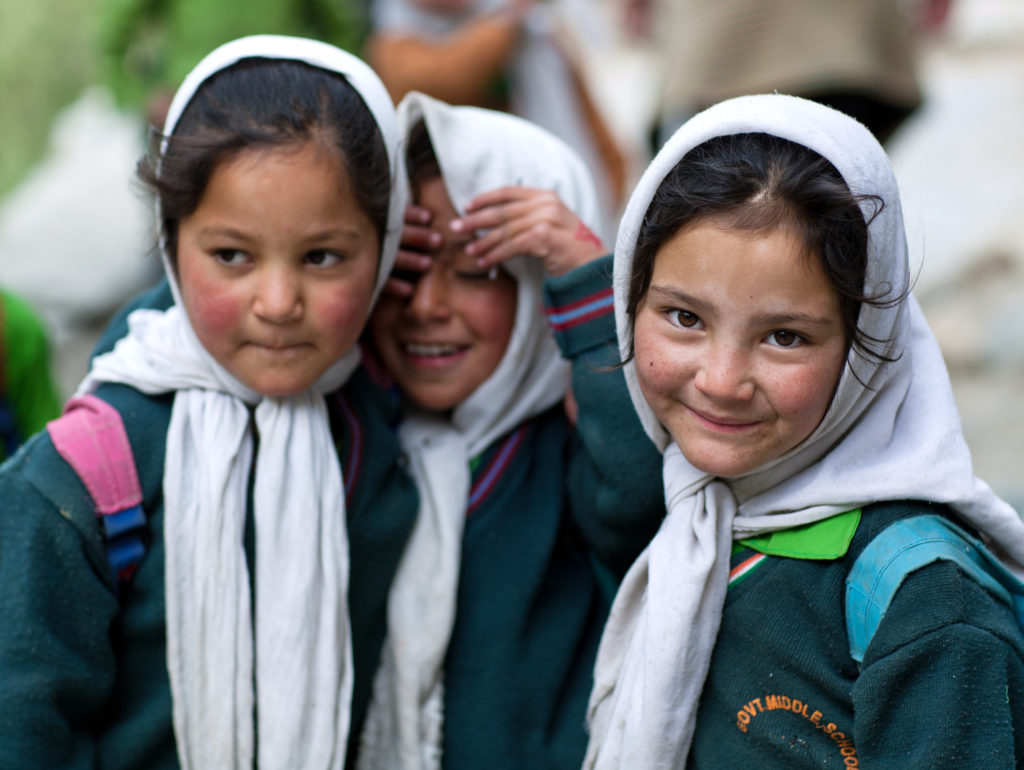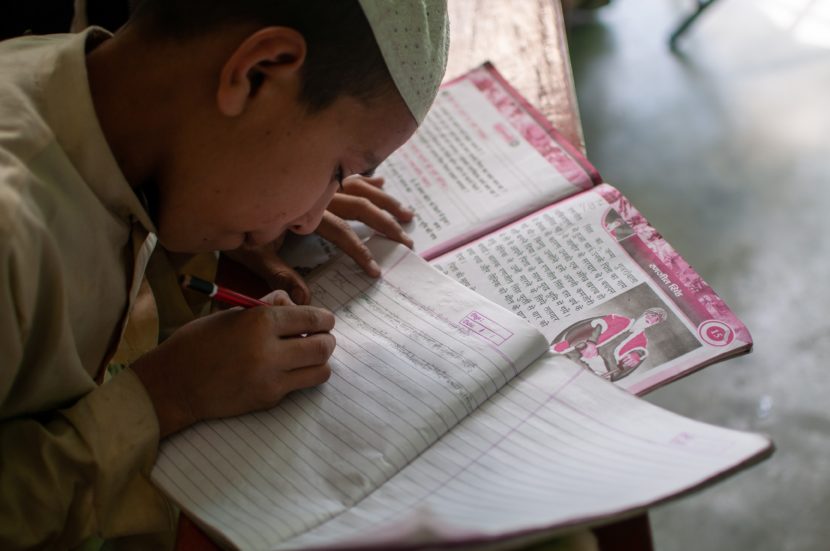Muslim children in Indian education face discrimination and challenges that hinder their access to quality learning opportunities. Despite comprising around 14% of the population, Muslims encounter obstacles such as declining enrollment rates, contentious bans on religious attire like the hijab, and the closure of Islamic schools (madrasas). These issues exacerbate educational disparities and contribute to a climate of prejudice and Islamophobia in schools.
Religious demographics in India
In India, Hindus form the predominant religious group, comprising approximately 80% of the population. Muslims constitute around 14%, establishing a significant minority presence. The remaining 6% of the population consists of various religious communities including Christians, Sikhs, Buddhists, and Jains, each contributing to the diverse religious tapestry of the nation (Pew Research Center, 2021).
All religious groups have witnessed population growth over the past 70 years. However, despite accusations of a “population growth agenda” by some Hindu groups, government data shows that Muslim fertility rates are declining faster than any other major religious group in India. Between 1992 and 2021, the average number of children per Muslim woman fell from 4.41 to 2.36, while for Hindus, it dropped from 3.3 to 1.94. Nevertheless, the government has increasingly marginalized Muslims, including Muslim children (Sharma, 2024).
Islamophobia in Indian schools
A 2006 report highlighted the severe discrimination and deprivation experienced by Muslims in India across all socio-economic levels. The report underscored the “deplorable conditions of Muslims” concerning poverty, education, and employment. Seven years later, a study by the U.S. India Policy Institute found that Muslims had not shown any significant improvement, particularly in education (Sacks, 2017).
Critics, such as the head of the Economics Department at SNDT Women’s College in Mumbai, lamented the government’s meager assistance and described Muslim progress as marginal. The college enrollment rate among Muslims remains the lowest among all religious groups in India, with only 11 out of every 100 Muslim students enrolling in higher education. This disparity is even more pronounced in rural areas, where the majority of India’s population resides (Sacks, 2017).
In addition, a literary work published in India in 2018 shed light on the escalating discrimination targeting Muslim children within exclusive school environments, reflecting the increasing prevalence of Islamophobia. Author Nazia Erum interviewed 145 families and 100 children across 12 cities, revealing instances of children as young as five facing discrimination based on their religious identity. Many cases go unreported due to fear of being labeled as tattletales, leading to a trend of self-censorship among Muslim children (Pandey, 2018).
Muslim students’ education struggles in India
Educational disparities for Muslim students in India are worsening, with recent reports showing a decline in their enrollment across all levels of education. From 2019/20, Muslim student enrollment dropped by 8%. Adding to these concerns is the controversial ban on wearing hijab in the educational institutions of Karnataka, India’s sixth-largest state, implemented in 2021 (Citizens for Justice and Peace, 2023).
This ban sparked a nationwide debate, raising significant concerns about the discrimination against the rights of Muslim women and girls. Approximately 1,010 hijab-wearing girls dropped out of pre-university colleges in Karnataka due to the ban. The timing of the ban, coinciding with end-of-year examinations, exacerbated its impact (Citizens for Justice and Peace, 2023).
Moreover, in December 2020, the northeastern state of Assam enacted a law mandating the conversion of all Islamic schools (madrasas) into regular educational institutions. The then education minister stated that this move aimed to ensure equal education rights for all children and facilitate access to higher education, though this move was contested as not achieving its intended goal in practice (Mogul, 2024).
Understanding troubling school shifts

In 2024, the high court in Uttar Pradesh, India‘s most populous state, ordered the transfer of students from Islamic schools (madrasas) to mainstream institutions under the pretext of emphasizing the state’s duty to provide secular education, thereby prohibiting religious-specific teachings (Mogul, 2024).
It’s important to note that madrasas, acknowledged by UNESCO for their historical significance, have long acted as universal hubs for education and cultural interaction. Nowadays, they still offer a wide range of subjects worldwide, including theology, science, history, and philosophy, as well as language, literature, music, and etiquette (UNESCO, n.d.).
Madrasas typically offer instruction in the Quran and Islamic history in addition to standard subjects. In contrast, some Hindus opt for gurukuls, where Vedic scriptures are taught alongside conventional education under the guidance of a guru (Mogul, 2024). However, it is noteworthy that while the government has targeted madrasas, which have been providing free education to many economically disadvantaged students, it has not taken similar action against gurukuls (Roy, 2022).
The court order directly impacts around 16,500 madrasas, their 1.95 million students, and 100,000 teachers. Among these students are many non-Muslims, predominantly Hindus. The closure of madrasas could lead to an additional increase in the dropout rate among Muslims. Despite serving as effective educational institutions, the decision to shut down madrasas raises concerns about injustice and intolerance (Rahman, 2024).
Additionally, this decision also directly contravenes Article 30(1) of the Indian Constitution, which guarantees linguistic and religious minorities the fundamental right to establish and administer educational institutions of their choice. The National Commission for Minority Educational Institutions Act of 2004 was enacted to safeguard these educational rights (NCMEI, n.d.).
Steps towards equality in India
The challenges facing Muslim children require immediate attention and robust policies to promote inclusive education, address socio-economic disparities, and ensure equal opportunities. Providing targeted support for marginalized communities and removing barriers to their educational and professional advancement are vital. Additionally, promoting social inclusion, economic empowerment, and political representation are essential for achieving equality in Indian society (Citizens for Justice and Peace, 2023).
Additionally, rights groups like Human Rights Watch have reported that nationalist groups have threatened and harassed Muslim and other religious minorities without facing consequences under the current governments (Sharma & Das, 2024). To address the issue, nationalist groups must face consequences for threatening and harassing religious minorities. This entails enforcing anti-discrimination laws and implementing policies promoting tolerance and inclusivity.

Humanium has made significant strides in promoting inclusivity and equality for all children in India, regardless of their religious beliefs. Since 2009, in partnership with Hand in Hand India, we have tackled discrimination through projects like the Residential Special Training Centre in Madhya Pradesh.
This initiative continues to provide education and support to former child laborers, significantly improving their living conditions. If you want to support our cause and help us continue our mission of ensuring a brighter future for children in India, please consider volunteering, donating, or sponsoring a child.
Written by Lidija Misic
Bibliography:
Citizens for Justice and Peace (2023), Educational inequities worsen for Muslim students in India. Retrieved from CJP at https://cjp.org.in/educational-inequities-worsen-for-muslim-students-in-india/, accessed on June 26, 2024.
Mogul Rhea (2024), Court ruling effectively outlaws Islamic schools in India’s most populous state. Retrieved from CNN at https://edition.cnn.com/2024/03/24/india/india-madrasa-court-ruling-uttar-pradesh-intl-hnk/index.html, accessed on June 26, 2024.
NCMEI (n.d.), The National Commission for Minority Educational Institutions. Retrieved from The National Commission for Minority Educational Institutions at https://ncmei.gov.in/about-department/about-us-2/, accessed on June 26, 2024.
Pandey Geeta (2018), The Indian schoolchildren who are bullied for being Muslim. Retrieved from BBC at https://www.bbc.com/news/world-asia-india-42650106, accessed on June 26, 2024.
Pew Research Center (2021), Religious Composition of India. Retrieved from Pew Research Center at https://www.pewresearch.org/religion/2021/09/21/religious-composition-of-india/, accessed on June 26, 2024.
Rahman Azizur Shaikh (2024), Muslims in India’s most-populous state protest ban on madrasas. Retrieved from Voice of America at https://www.voanews.com/a/muslims-in-india-s-most-populous-state-protest-ban-on-madrasas/7554759.html, accessed on June 26, 2024.
Roy Esha (2022), Why action against only madrasas, why not gurukuls: AIMPLB. Retrieved from The Indian Express at https://indianexpress.com/article/political-pulse/why-action-against-only-madrasas-why-not-gurukuls-aimplb-8130943/, accessed on June 26, 2024.
Sacks Brianna (2017), Education for the Voiceless: India’s Muslim Students Still Ignored and Underserved. Retrieved from Huffington Post at https://www.huffpost.com/entry/muslim-students-india_b_5253276, accessed on June 26, 2024.
Sharma Yashraj (2024), Has India’s Muslim population really exploded? Retrieved from Al Jazeera at https://www.aljazeera.com/news/2024/5/18/has-indias-muslim-population-really-exploded, accessed on June 26, 2024.
Sharma Saurabh & Das N. Krishna (2024), Thousands of Indian teachers set to lose jobs as Muslim school funding ends. Retrieved from Reuters at https://www.reuters.com/world/india/indian-state-cuts-pay-some-teachers-muslim-religious-schools-2024-01-11/, accessed on June 26, 2024.
UNESCO (n.d.), Cultural Selection: Madrasas as Universal Centers of Education and Culture. Retrieved from UNESCO at https://en.unesco.org/silkroad/content/cultural-selection-madrasas-universal-centers-education-and-culture, accessed on June 26, 2024.


